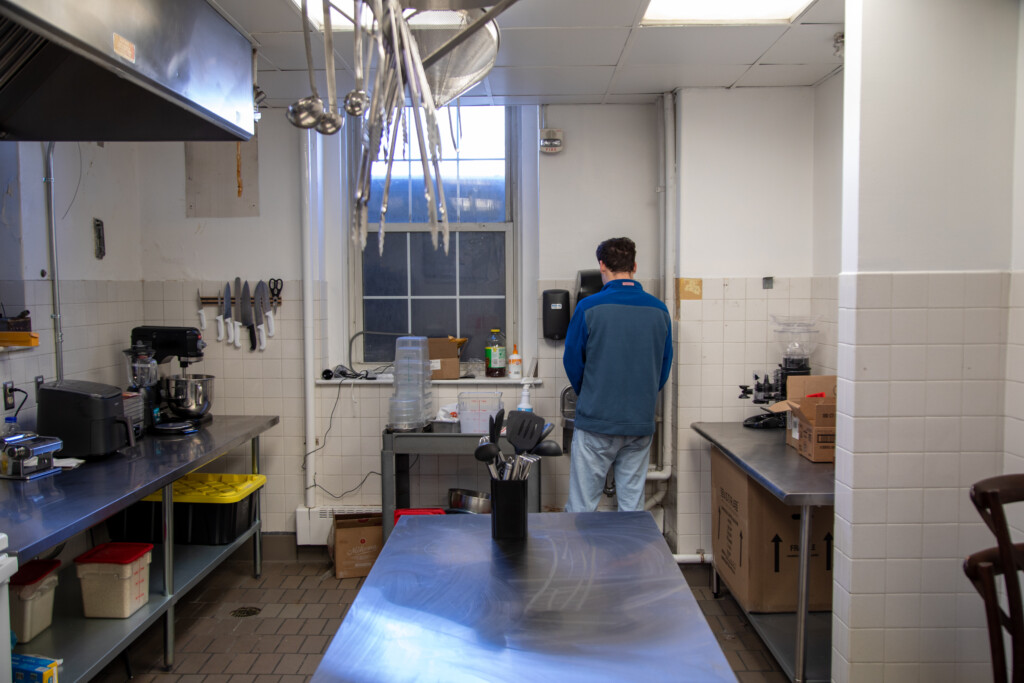On Tuesday, renowned author and speaker James Kuntsler gave a talk entitled “We’re in Trouble” at The German House. This lecture was the fourth in a series of lectures developed by The Rochester Regional Community Design Center and the American Institute of Architects.
The series focuses on the revitalization of downtown Rochester. “It is an attempt to educate and excite everyone in the community – from the mayor and his staff, to the private developers, the bankers, the educators and of course the general public – about possibilities for making downtown Rochester a beautiful and vibrant community again!” Project and Program Coordinator for RRCDC Audrey Stewart ’05 said.
Kuntsler, an expert in the field of urban renewal, has written nine novels and is a regular contributor to The New York Times Sunday Magazine and Op-Ed page. His latest nonfiction book, The Long Emergency, describes the changes that American society will face in the 21st century. This subject was also the focus of his talk, which opened with a slide that simply said, “You are in for a threat” on it.
Kuntsler went on to discuss the oil crisis and how global warming will lead to more disastrous storms like hurricanes Katrina and Rita.
“The global oil predicament is going to change everything about how we live,” Kuntsler said.
Kuntsler insisted that if we don’t invest the bulk of our remaining resources into building communities that can function effectively without oil and instead use our remaining oil on everyday consumerism, then the world will be in a difficult plight.
According to Kuntsler, without oil, we will not be able to build what we will need when we don’t have oil as a resource anymore. Some examples he gave were nuclear power plants, mass transit systems that run on electricity and energy efficient homes.
“The counter argument of suburbia being okay because Americans like it is no longer acceptable” Kuntsler said.
The second half of Kuntsler’s talk went on to discuss the problems with the architecture of public spaces in America. He praised Europe’s architectural talent and ability to draw people to public spaces.
“We have to bribe people to go to public places in America,” Kuntsler said.
He noted that much of our new architecture is reminiscent of DVD players and is covered with “nature band-aids” to try to make it more inviting.
Kuntlser was very critical of American architects and the complacency of the American people in general, but the large crowd found him to be quite humorous and enjoyable. His lecture was followed by an extensive question and answer period.
The Rochester Regional Community Design Center, located in downtown Rochester, is an organization of volunteer design professionals that offer design guidance and recommendations through a participatory planning process.
The Center has been active since the late 1990s and has facilitated many community charettes including Clinton Avenue, University Avenue and the Rochester downtown charette. The work of the center brings a collaboration of community residents together with professionals to develop workable plans for achieving community design goals.
Five UR students have had internships at the center this semester. The internships consist of interacting on-site with the design center and an academic portion instructed by art history professor Joan Saab.
Senior intern Rosie Adams, who will be attending Cornell University for design & environmental analysis/environmental psychology in the fall, wanted to get involved in the ‘real’ world of urban-building design while she was still in Rochester. Adams approached UR Architect Paul Tankel who suggested she get in contact with Stewart.
At RRCDC, Adams has been documenting the lecture series and putting together a comprehensive educational booklet covering the entire lecture series. The booklet will include factual information on the lecture series, but also audience commentary on how the series has been of value to them, and the city as a whole.
“I have found it fascinating to compare the urban design theory from my assigned readings to the reality of urban design practice in Rochester,” Adams said. “Through the lecture series and my time at RRCDC, I have been exposed to a wealth of new knowledge and interesting people. And, while Rochester faces some very challenging urban issues, I have realized that there are many Rochester citizens who are dedicated to making Rochester a more livable, healthy city. When you look more closely at the architecture of Rochester, you realize it has so much potential to be a vibrant, exciting city and progress is being made towards that end. The internship has definitely opened my eyes to a whole new side of Rochester that I never saw before stepping outside of the campus classroom.”
The next lecture in the series will be on May 17 and will feature Norman Mintz, Main Street expert and founder of Corning’s Main Street initiative.Lepore can be reached at mlepore@campustimes.org.

